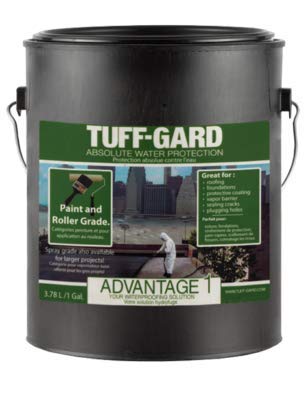Metal roofing is notorious for rust, cracks between seams, holes where nails or screws were used to affix them, and wind damage.
There are a number of solutions to remedy a damaged metal roof, among the best-known repair solutions, are metal roof screw sealant. These metal roof repair sealant kits are numerous and easy to find, buy and apply.
Here is the list of the 5 best products, and this review article closes with an FAQ and roof repair 101.
List of Top-Rated Metal Roof Sealants
| Photo | Name | Color | Unit | Description |
|---|---|---|---|---|
 | Sashco 14010 | Transparent | Cartridge | View on Amazon |
 | Tuff-Guard Heat-Block | White | Gallon | View on Amazon |
 | Tuff-Guard ADV1-1GAL | White | Gallon | View on Amazon |
 | Franklin 61781 | Many | Cartridge | View on Amazon |
The Best Metal Roof Sealants Reviews
Navigation
Sashco 14010

Through the Roof!® is a clear, waterproof, ultra-elastic sealant. This product is best used to stop and prevent leaks, it is waterproof, and since its clear, you can use it over finished surfaces without damaging the design features of color.
Features
Through the Roof!® can be applied in temperatures down to 0°F and sticks to wet surfaces so you can apply this in all weather condition. It is also UV resistant, so it will work well in hot sunny climates as well as cold ones, and where there are extreme temperature changes, this product is superelastic and doesn’t dry and crack.
Specification
- Color: Clear
- Packaging: 10.5 oz. plastic cartridge, 1 quart and 1 gallon containers
- Joint Size: Cartridge – up to 2” wide; Brush grade – N/A
- Paint Usage: latex paint: stain in 24 hours; oil-based paint stain after 1 week
- Clarity (NTU): Cartridge grade – < 13; Brush grade – < 15
- Application Range: 0°F to 120°F (-18°C to 49°C) surface temperature
- Service Range: -25°F to 180°F (-34°C to 82°C)
- Tensile Properties: Cartridge – Recovery; at 50% stretch: 96% in 1 minute; at 100% stretch: 96% in 1 minute; Brush – Recovery; at 50% stretch: 100% in 3 minutes; at 100% stretch: 96% in 5 minutes
Tuff-Guard Heat-Block

Tuff-Gard Heat Block Reflective Coating is a rubberized brilliant white reflective coating that is best used as a waterproofing sun protectant in hotter climates.
Features
Tuff-Gard Heat Block Reflective Coating is a full coating product used to both rubberize the roof surface as well as provide a brilliant white reflective coating to reflect harsh sunlight. This product, when applied over the roof surface provides you with over 88% Solar Reflectance and over 90% Thermal Emittance.
Specifications
- Qualification for LEEDS applications
- Rubberized Components to Increase Elasticity
- Anti-Mildew agents to Prevent Mildew Growth
- Anti-Bacterial agents to Prevent Bacteria build up
Tuff-Guard ADV1-1GAL

Tuff-Gard Advantage 1 is a single component Rubberized, Solvent-free and waterproof coating for your roof.
Features
Tuff-Gard Advantage 1 is 100% Waterproof. This is an all surface coating product that is perfect for anything from a small crack fill job to a total coating application:
- Can be brush applied
- For larger applications use a roller or squeegee
- Can be applied to moist areas
- Not intended for use as a walking surface
- Adheres well to all types of foam, concrete, stone, wood, cement, metal and EPDM
- Eco-Friendly and Minimal odor
Specifications
- Elongation: >1800%
- Low Temperature elongation: @ 22F >500%
- High Temperature Aging for 48 days @ 176F: Elongation >300% min.
- Service Temperature: -35F to 176F
- Water Absorption Weight change 1.02% maximum
- Water Vapour Transmission 0.08 grains /hr/ft
- Permeance 0.16 grains/hr/ft/in Hg (perms)
- Resistance to Hydrostatic Head >150 ft water
- Class A Fire Rating
Franklin 61781

Titebond® WeatherMaster™ Metal Roof Sealant is a polymer formula that provides waterproof and dustproof seal solutions for all roof products.
Features
The WeatherMaster adheres to Kynar™ coated metal materials, and all standard metal, aluminum, steel, galvanized bonderized surfaces, plastics and glass.
This sealant comes in 50 different colors so you can match your seal to any design, it also comes with a transparent variant.
The Weathermaster is applicable in extreme weather conditions, with temperatures as low as 0°F/-18°C. The UV resistant properties make this a perfect choice for sunny climates too.
You can paint over this product using a water-based (latex-based) paint one hour after application.
Features
- Adheres to Kynar™ coated metals
- Applies easily in extreme weather conditions
- Excellent adhesion to most common building materials
- Permanently flexible, weather-tight seal
- UV-resistant
- VOC-compliant
- Compatible with all types of foam
How to fix a metal roof
Metal roofing comes with a number of issues, and these include:
- Open seams
- Open penetration flashings
- Metal roof oxidation
- Fastener backout
- Open ridge/headwall flashing
- Loose counterflashing
- Improper installation methods
- Panel damage
There are a number of options to choose from when dealing with roof problems, and these include repairing, restoring and replacing the roof materials.
Metal Roof Repair and Replacement Options: Repair versus Restoration versus Replacement
Repairing a roof requires ongoing maintenance, and when you maintain a metal roof, it will last for up to 30 years or more. You should look at the status of the roof every half a year and fix any problems before they become extreme.
The most common issues include open seams and oxidation, both of which are easily repaired.
Restoration is when you make a comprehensive repair of all the roof, which means cleaning all the roof surface and seams, applying rust inhibitors, undercoats and top coats. You might consider adding a sun or waterproofing sealant.
Replacement is usually performed when repair and restoration are costlier than replacing the metal sheets. You simply buy a new sheeting and replace the old ones with the new ones.
How to fix a leaking tin roof
Corrugated metal roofs do get damaged from excessive moisture and strong winds. The two key components that tend to get affected first are the seams and the steel nails or screws used to attach the roofing sheets.
First, locate the problem, and then ascertain what needs to be done. Will a simple repair job suffice, or do you need to restore the whole section? Perhaps you need to replace the sheet with a new one. Let’s look at the basic leak fix job, where either a seam has parted, or a nail has rusted.
Remove all the nails that are rusted and check the sheet for roof corrosion damage. Scrape off all rust from the hole area and coat the damaged area with a rust inhibitor. Let that dry and then coat it with paint and let that dry too. Now hammer in a new nail and then cover it with a sealant.
Check the damaged seams for corrosion, if there is rust, perform the same preparatory action as above, if not, go to the next step in the process. Remove all the loose caulking and adhesives and clean the area. Apply a roof sealant to the seam and close it up.
Another area to check is the roof panel edges where they overlap, check for gaps and cover the overlapping areas with fabric tape, you can smear a sealant onto the area and then cover with the fabric. After an initial dry time, cover it with a waterproofing, or weatherproofing coating.
How to waterproof a metal roof
- Make sure all the roof surface is dry.
- If there is rust brush it and remove it completely.
- Apply metal primer over all the roofing.
- When the primer has dried apply a coat of waterproofing compound along with the sheet overlaps, metal screws and nail heads and all flashings. You can also use strips of fabric along seams and coat them again with a sealant after the first layer has dried.
- After completing these stages, you can coat the entire roof with a coating of sealant and over that an all-weather paint.
How to paint a steel roof
Painting directly onto galvanized steel is not recommended. It’s always best to put on a layer of primer first. After the primer has dried, apply an all-weather sealant.
Once all the pre-paint stages have fully cured, you can now apply a coat of paint. There are three methods, and they are all reliant on the type of roofing you took.
Brush, roller and spray work well, each one is used for a different shape of the material, where brush and spray work well with all surfaces, rollers only work well on flat surfaces.
- Remove the old paint and rust before starting any roof paint job.
- Make sure that the paint you choose is an all-weather paint designed to paint over polymer surfaces or primer paint.
- Always use a sturdy ladder and work as a team of two, where one is up to the ladder painting, the second is preparing the paint and watching the ladder’s stability.
- Always wear a harness when painting from a ladder.
- Only paint on dry days, and make sure the weather will remain dry for at least 3-4 days during and after the paint job.
- When applying primer and paint, make the strokes equal and in the same direction. Do not apply too thin a coating, be generous with your application.
- Check the complete drying time before applying a second coat; this means its best to wait at least one day between applying coats.
What paint to use on metal roof
Two types of paint to apply to all metal roofs, these are primers and paints.
Primer
There is no one solution for all, a primer is a special material and is not a paint. It is a substance that adheres to the surface of the metal and bonds on a molecular level. Paint is a surface coating that does not bond to metal and will peel without a coating of primer. The primer also bonds on the molecular level with paint. Essentially the primer is the center of a sandwich between metal and paint.
Paint
For roof applications, oil-based paint is the only option you want to choose. These are waterproof paints that will leave a smoother shinier surface than latex paints. There are also a number of brands that have developed “roof paint” designed specifically to withstand the harsh weather conditions and strong UV and IR rays of the sun. They also have a higher resistance to heat and cold changes.


Leave a Comment